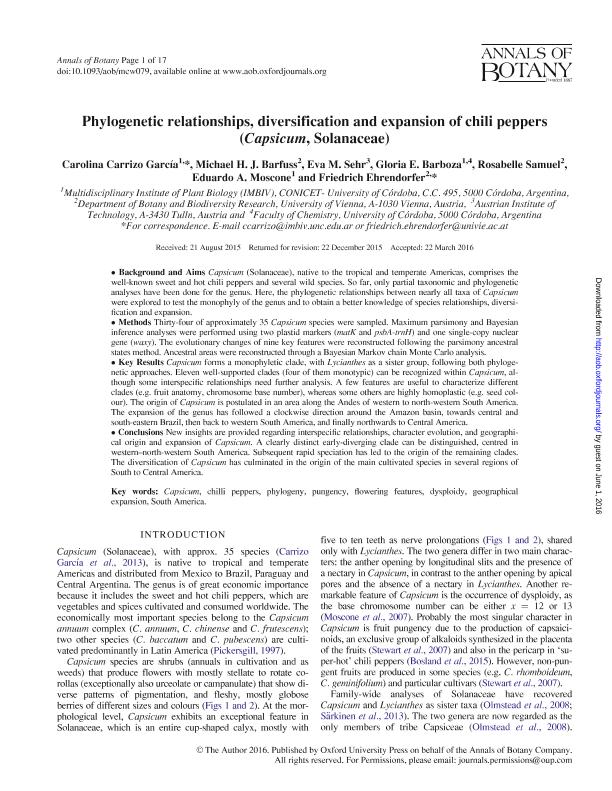Artículo
Phylogenetic relationships, diversification and expansion of chili peppers (Capsicum, Solanaceae)
Carrizo Garcia, Carolina ; Barfuss, Michael H. J.; Sehr, Eva M.; Barboza, Gloria Estela
; Barfuss, Michael H. J.; Sehr, Eva M.; Barboza, Gloria Estela ; Samuel, Rosabelle; Moscone, Eduardo Alberto
; Samuel, Rosabelle; Moscone, Eduardo Alberto ; Ehrendorfer, Friedrich
; Ehrendorfer, Friedrich
 ; Barfuss, Michael H. J.; Sehr, Eva M.; Barboza, Gloria Estela
; Barfuss, Michael H. J.; Sehr, Eva M.; Barboza, Gloria Estela ; Samuel, Rosabelle; Moscone, Eduardo Alberto
; Samuel, Rosabelle; Moscone, Eduardo Alberto ; Ehrendorfer, Friedrich
; Ehrendorfer, Friedrich
Fecha de publicación:
03/2016
Editorial:
Oxford University Press
Revista:
Annals of Botany
ISSN:
0305-7364
e-ISSN:
1095-8290
Idioma:
Inglés
Tipo de recurso:
Artículo publicado
Clasificación temática:
Resumen
Background and AimsCapsicum (Solanaceae), native to the tropical and temperate Americas, comprises the well-known sweet and hot chili peppers and several wild species. So far, only partial taxonomic and phylogenetic analyses have been done for the genus. Here, the phylogenetic relationships between nearly all taxa of Capsicum were explored to test the monophyly of the genus and to obtain a better knowledge of species relationships, diversification and expansion.
Methods Thirty-four of approximately 35 Capsicum species were sampled. Maximum parsimony and Bayesian inference analyses were performed using two plastid markers (matK and psbA-trnH) and one single-copy nuclear gene (waxy). The evolutionary changes of nine key features were reconstructed following the parsimony ancestral states method. Ancestral areas were reconstructed through a Bayesian Markov chain Monte Carlo analysis.
Key ResultsCapsicum forms a monophyletic clade, with Lycianthes as a sister group, following both phylogenetic approaches. Eleven well-supported clades (four of them monotypic) can be recognized within Capsicum, although some interspecific relationships need further analysis. A few features are useful to characterize different clades (e.g. fruit anatomy, chromosome base number), whereas some others are highly homoplastic (e.g. seed colour). The origin of Capsicum is postulated in an area along the Andes of western to north-western South America. The expansion of the genus has followed a clockwise direction around the Amazon basin, towards central and south-eastern Brazil, then back to western South America, and finally northwards to Central America.
Conclusions New insights are provided regarding interspecific relationships, character evolution, and geographical origin and expansion of Capsicum. A clearly distinct early-diverging clade can be distinguished, centred in western–north-western South America. Subsequent rapid speciation has led to the origin of the remaining clades. The diversification of Capsicum has culminated in the origin of the main cultivated species in several regions of South to Central America.
Palabras clave:
Capsicum
,
Chilli Peppers
,
Phylogeny
,
Pungency
Archivos asociados
Licencia
Identificadores
Colecciones
Articulos(IMBIV)
Articulos de INST.MULTIDISCIPL.DE BIOLOGIA VEGETAL (P)
Articulos de INST.MULTIDISCIPL.DE BIOLOGIA VEGETAL (P)
Citación
Carrizo Garcia, Carolina; Barfuss, Michael H. J.; Sehr, Eva M.; Barboza, Gloria Estela; Samuel, Rosabelle; et al.; Phylogenetic relationships, diversification and expansion of chili peppers (Capsicum, Solanaceae); Oxford University Press; Annals of Botany; 118; 1; 3-2016; 35-51
Compartir
Altmétricas



